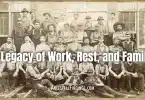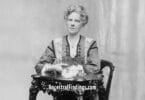Lincoln Logs are a popular toy for children in the United States. Their status as all wood building toys makes them special and unique in a world of plastic and electronic toys. While being somewhat old-fashioned, they are still as popular a toy for young children as they ever were, which proves some types of fun never go out of style. So, what exactly are Lincoln Logs and how did they come to be invented? The story is a surprising and interesting one.
Lincoln Logs were invented between 1916 and 1917 by John Lloyd Wright, the son of famous U.S. architect Frank Lloyd Wright. The idea for Lincoln Logs came to John Lloyd Wright when he was working with his father in Japan on building the Imperial Hotel in Tokyo. The hotel’s foundation was made of beams of wood that interlocked with each other. The interlocking structure was supposed to make the building earthquake-proof since earthquakes were (and still are) an issue of concern in Japan. With the nation being on such an active seismic area, they get earthquakes often. It is important their buildings are able to withstand even the harshest of earthquakes, especially the large skyscrapers. The Wrights aimed to create this type of building using a structure for the foundation that made it more secure.
John Lloyd Wright was inspired by this foundation design and saw the potential for a building type of toy with the interlocking wooden beams. He designed the Lincoln Logs to match the types of beams his father used on the Imperial Hotel in Tokyo. When he came back to the United States, he started the Red Square Toy Company, which was named after a famous symbol his father used in his building designs. John officially began marketing Lincoln Logs in 1918.
He applied for and was issued a patent for the toy. The official patent was awarded to him on August 31, 1920, and stated it was for a toy cabin construction set. After receiving the patent, John changed the name of his toy company to J.L. Wright Manufacturing.
The original Lincoln Log toy set was accompanied by a set of instructions on how to build the eponymous cabin from the book Uncle Tom’s Cabin, as well as instructions for building Abraham Lincoln’s boyhood cabin. The Lincoln Logs became popular quickly, and the basic initial set was soon expanded to include more logs of a greater variety of sizes. With the increased number and sizes of logs, children were able to build much more types of buildings and could exercise their creativity to a much greater extent when playing with the logs. Lincoln Logs were just as popular as Tinker Toys and Erector Sets, which were invented and introduced to the market a few years before the Lincoln Logs. It seemed that children loved to build things, and loved toys that allowed them to build. Lincoln Logs were just one of a variety of building toy sets that gained a lot of fame that endures to this day.
The origin of the name Lincoln Logs is disputed. K’Nex, the current distributor of Lincoln Logs, says they were named after former U.S. president Abraham Lincoln because he was born in an old-fashioned log cabin (due to popular legend), and the name invoked patriotism during WWI when the toy was invented. Other people who were intimate with John Lloyd Wright or those who knew people who knew John said the name came from Frank Lloyd Wright’s original name of Frank Lincoln Wright, or even that the name was a play on the term “linking logs,” which is what the logs did.
The logs have always been designed to resemble real logs that would be used to build a log cabin, with notches in them so they can be laid across each other at right angles and locked into place until the logs are moved by a human. In addition to the logs of varying sizes, today’s Lincoln Logs sets come with accessories like windows, doors, roofs, and more, which can allow children to make more realistic looking buildings. The original Lincoln Logs were made of redwood. The company changed to plastic logs in the 1970s, but these proved incredibly unpopular. The company soon went back to making sets made of real wood, and they continue to be made of real wood today. The toy has been so popular over the generations that it was introduced into the National Toy Hall of Fame in 1999, an honor this remarkable toy of innovation and imagination deserves.






